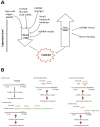miRNA: A Promising Therapeutic Target in Cancer
- PMID: 36232799
- PMCID: PMC9569513
- DOI: 10.3390/ijms231911502
miRNA: A Promising Therapeutic Target in Cancer
Abstract
microRNAs are small non-coding RNAs that regulate several genes post-transcriptionally by complementarity pairing. Since discovery, they have been reported to be involved in a variety of biological functions and pathologies including cancer. In cancer, they can act as a tumor suppressor or oncomiR depending on the cell type. Studies have shown that miRNA-based therapy, either by inhibiting an oncomiR or by inducing a tumor suppressor, is effective in cancer treatment. This review focusses on the role of miRNA in cancer, therapeutic approaches with miRNAs and how they can be effectively delivered into a system. We have also summarized the patents and clinical trials in progress for miRNA therapy.
Keywords: cancer; miRNA; miRNA delivery; oncomiR; therapy; tumor suppressor.
Conflict of interest statement
The authors declare no conflict of interest.
Figures





References
Publication types
MeSH terms
Substances
LinkOut - more resources
Full Text Sources
Medical

